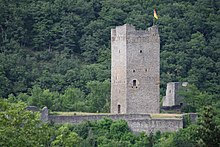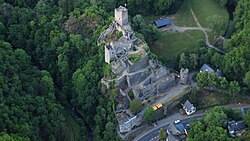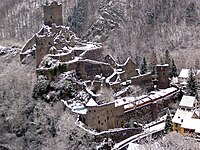Manderscheid castles
Near the Eifel town of Manderscheid are the ruins of two castles , the history and location of which reflect the medieval conflict of interests between the Electorate of Trier and the Duchy of Luxembourg .
The upper castle
The upper castle is located on a mountain peak that has been flattened for its construction. As can still be seen today from the ruins, it had an almost triangular outer wall and a five-storey keep, which has now been made accessible again . From the keep you have an excellent view of the Niederburg, the town of Manderscheid and the landscape of the Liesertal .
The place name Manderscheid is documented for the first time in a deed of donation from Otto II to the Archbishop of Trier from the year 973. This does not go hand in hand with the first mention of the castle, as can be read several times in the literature. Historically, it only becomes tangible during the feud between Count Heinrich the Blind of Namur-Luxemburg and Archbishop Albero of Trier between 1141 and 1146 over the Abbey of St. Maximin in front of Trier . The noble free from Manderscheid appear for the first time in 1142 in the list of witnesses in a deed of gift. The place Obermanderscheid was named after the Kurtrierische Amt Manderscheid , which existed until the end of the 18th century. However, the administrative seat was not in the castle, but in the cellar of the neighboring town, to which Elector Baldwin granted city rights in 1332 (according to other sources, King Ludwig the Bavarian did this as part of a collecting privilege). The local possessions of the Elector of Trier represented a bridgehead in the surrounding Luxembourg territory . In 1673 the castle, still owned by Kurtrier, was finally destroyed by French troops.
Today: The ruins of the upper castle were completely renovated in 1921 by the Manderscheid community, who owns them, and are freely accessible.
The Niederburg
The Niederburg is located on a rock in the Liesertal below the Oberburg within a stone's throw of it. But it is separated from the upper castle by the Lieser river , which surrounds the Niederburg on three sides. This valley location once had the advantage of being able to control traffic and shut off in the event of a conflict.
In 1173 (according to other sources 1133) the Niederburg was first mentioned in a document. It is the ancestral seat of the Lords of Manderscheid, who became important for the Eifel (and partly beyond) in the Middle Ages and ruled here as bailiffs of the Echternach Abbey on Luxembourg territory. In the course of time, large areas of the Gaus Bedense ( Bitburg ), including the suburb of Niedermanderscheid, had been donated to the abbey from royal property.
A considerable expansion of the castle and the fortifications took place under Wilhelm V. von Manderscheid, who also extended them over the suburb of Niedermanderscheid.
From 1346 to 1348 the castle was besieged by the troops of the aforementioned Elector Baldwin of Trier, which it survived unconquered.
Finally, in 1457, Dietrich III. awarded the title of imperial count by Manderscheid . He had three sons, so that after his death the Manderscheid family split up into the lines Manderscheid- Kail (son Wilhelm), Manderscheid- Schleiden (son Cuno) and Manderscheid- Blankenheim (son Johann) according to the parts of the original domain that fell to them . The Niederburg remained in the possession of the Lords of Manderscheid-Blankenheim, who, however, no longer inhabited it, left it to decay. Countess Augusta was the last of the Manderscheid-Blankenheim line to rule, before she and her family had to flee from the approaching French troops to the lands of her husband, Count von Sternberg , in Bohemia in 1794 . The castle was destroyed by the French.
The ruins of the Niederburg have been owned by the city of Manderscheid since January 1, 2018. The city has leased the operation and management of the two castles to the Burgenverein Manderscheid eV. The association is responsible for the operation, administration and marketing of the Upper and Lower Castle. The Niederburg can be visited every day during the summer months (except Tuesdays). Group tours are possible on request. The castle can also be booked for private events (e.g. weddings). On the last weekend in August each year, a medieval festival takes place in the castle and the adjoining tournament meadow, which is attended by around 15,000 visitors.
Both castles are the subject of works of fine art. By Eugen Bracht there ever a painting of every castle that originated on different trips.
Niederburg: Engraving by Frans Hogenberg , 1576
literature
- Friedrich Toepfer: Supplements XVII. The gentlemen from Manderscheid . In: ders. (Ed.): Document book for the history of the royal and baronial house of the Voegte von Hunolstein , vol. I. Jacob Zeiser, Nuremberg 1866, pp. 354–356 ( Google Books )
Web links
- Entry on Niederburg Manderscheid in the scientific database " EBIDAT " of the European Castle Institute
- Entry on Oberburg Manderscheid in the scientific database " EBIDAT " of the European Castle Institute
- Website of the Niederburg Manderscheid
- Reconstruction drawing of the Niederburg by Wolfgang Braun
- Reconstruction drawing of the upper castle by Wolfgang Braun
- Detailed views of the Manderscheider Niederburg
- Detailed views of the Manderscheider Oberburg
- Illustration by Daniel Meisner from 1625: Manderscheidt; Múß, a bitter Kraútt ( digitized version )
Individual evidence
- ↑ Cf. Gesta Alberonis auctore Balderico, in: MGH SS VIII, p. 253
- ↑ Historical castle festival Manderscheid
Coordinates: 50 ° 5 ′ 32 ″ N , 6 ° 49 ′ 6 ″ E





